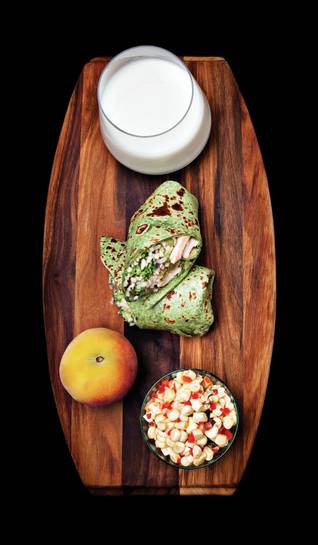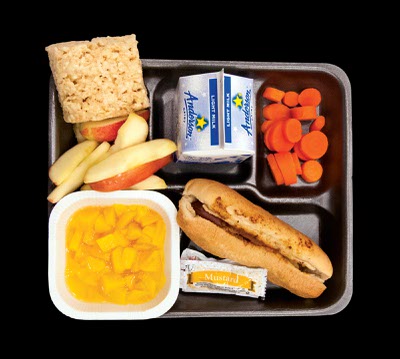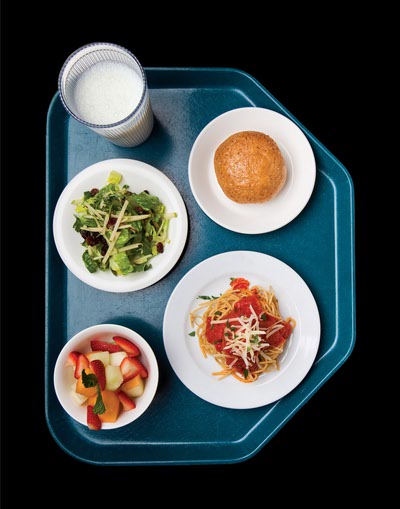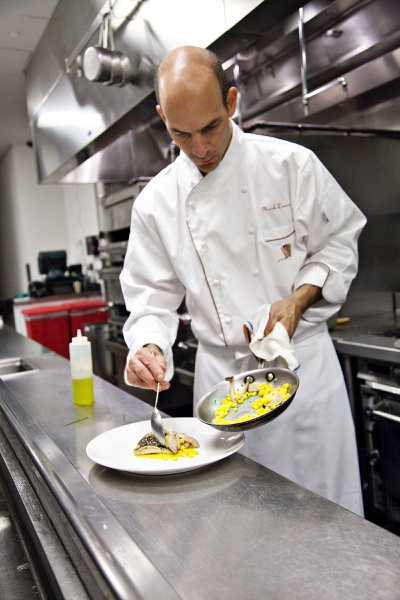
Chef school lunch: Botero’s Mark LoRusso upgraded his grilled chicken wrap with brown rice, vegetables and a corn salad on the side. He came in under the minimum calorie requirement at 651, but had trouble keeping the sodium in check, thanks to the tortilla used for the wrap.
Tuesday, May 29, 2012 | 2 a.m.
There will be no more Super Donuts, Karen Vogel says to the small group jotting notes in the margins of various charts and worksheets at this school nutrition training session. Most of us stare back at her blankly, so Vogel explains: Super Donuts are engineered Jetsons-esque breakfast pastries that were once “very, very, very popular” in school cafeterias. Injected with orange juice and made with suspicious-sounding “NutriDough,” they conveniently satisfied both fruit and grain school breakfast nutrition requirements in one super-processed super cake.
But Super Donuts are done, says Nevada Department of Education nutrition specialist Vogel. The USDA is updating the dietary standards of the National School Lunch Program and changing almost everything for the food service directors who manage school lunch menus across Nevada. Out is the idea of counting nutrients and arriving at mandated totals however you can. In is a system that focuses on specific serving sizes of actual food broken into groups like vegetables, fruits, grains and meats. It’s real “scratch” food, as opposed to fortified lab creations. Because no matter how much juice you pump into a doughnut, it’ll never be an orange.
The words “school lunch” typically conjure up images of women in hairnets serving sloppy joes to squirming kids who’d rather eat something else. But when the USDA’s new national nutrition regulations go into effect this fall, every school lunch across the country will need to meet rigorous requirements based on food groups, calorie counts, sodium levels and saturated fats. It’s a concentrated strike against childhood obesity in a battle that’s increasingly being waged in school cafeterias. But all the spinach in the world won’t make kids healthier if it ends up in the trash can.
So, how do you create nutritious, balanced meals that taste fantastic?
This summer, school nutrition staffers across the country, including Clark County Food Service Assistant Director Virginia Beck, will ask themselves that question as they try to create menus that will be approved by their states and appreciated by their students. While the CCSD ponders the serving sizes for chicken nuggets and peach cups, 40 minutes away, a veritable army of chefs goes to work every day on the Las Vegas Strip. For a glimpse at what the new school lunches could be, we tapped that talent base and sought out a pair of local chefs willing to take on a challenge: Cook us a school lunch that meets the USDA’s regulations and doesn’t taste like the cafeteria line.

This is a real school lunch. Served to kids at Matt Kelly Elementary School in North Las Vegas. Under the USDA's new nutrition standards, going into affect for the coming school year, the whole wheat bun on the chili cheese dog and the two servings of fruit get to stay. The marshmallow square? Only two grain-based desserts will be allowed per week.
In a long, low-ceilinged kitchen beneath the Luxor, assistant executive chef Gerald Trujillo is making school lunch. Like every lunch that will be served to high school students come August, Trujillo’s meal must include a full cup of both fruits and vegetables, at least two ounces of grains (half of which are whole grain-rich), two ounces of meat or meat alternatives and a glass of milk. Calories come in at a daily average of 750-850; saturated fat accounts for less than 10 percent of total calories; and no trans fats are allowed at all. On top of that, the chef has just $2.77 to work with, the federal reimbursement figure for a free school lunch (although schools have to account for labor costs as well as food for that low price).
But this is no ordinary student meal. There’s a sprig of basil for garnish on the spaghetti and meatballs, homemade dressing atop the salad and a white napkin laid out beneath gleaming white plates. In place of students eating with plastic sporks against the clock, I’m taking leisurely bites. Compared to the Dunkin’ Donuts bagel I ate nearly every day of high school, this is a serious upgrade.
While this is his first school lunch, Trujillo has experience crafting delicious meals that make the health grade. At Luxor and Excalibur, he helped design recipes for the employee dining rooms, where MGM Resorts CEO Jim Murren has implemented the maximum 700-calorie Jim’s Plate in an effort to offer staff meals that are as healthy as they are convenient.
For Trujillo’s school lunch, small tweaks make a big difference: The chef uses whole wheat pasta under a fresh pomodoro sauce, substitutes turkey for more fattening meatballs and keeps his salad light with a dressing made from honey, vinegar, mustard and apple juice. Each calorie is calculated to the hundredth, and the final tally stands at 839.6 calories for the entire plate, though he might need to trim the portion of pasta and skip the whole-wheat roll to keep within the maximum count for total grains. The cost, which had Trujillo spooked initially, comes out to $2.45—well below the federal reimbursement level.
And Trujillo sees room for other chefs to get more involved in school nutrition. “We’ve got a lot of talent on the Strip, and this is a great challenge,” he says. “I think you’d see a lot of chefs jump on this.”
And why not? Las Vegas is packed with culinary talent, and plenty of local chefs have the skill and creativity to craft healthy, kid-friendly meals—and many have children of their own to teach them what students will and won’t eat. Nationally, Michelle Obama’s Let’s Move! initiative includes the Chefs Move to Schools program, which pairs chefs with local schools in an effort to tap their knowledge for classroom lessons or behind-the-scenes menu help. In places like Orange County, Florida, the program has been a huge success, thanks to buy-in from Disney chefs and public schools. But in Las Vegas, a seemingly obvious place for such a program to shine, the volunteer-based project has yet to see its first match.
Outside the CCSD’s Food Service headquarters in North Las Vegas, semis emblazoned with the words Cool Cuisine Café and collages of burgers and splashing milk pull in and out of docks. The complex covers a space the size of five football fields, and inside, the massive central kitchen is a maze of stainless steel and uniformed cooks, a well-oiled machine responsible for producing 70,000 breakfasts and 180,000 lunches every school day. Clark County is the fifth-largest school district in the country, and 57 percent of its students are approved for free or reduced lunch (though anyone approved gets meals for free). That’s a higher rate of free lunches than anywhere but LA and New York.
At Matt Kelly Elementary School, just off Martin Luther King and West Lake Mead, students file into the cafeteria through a door that says Mom’s Kitchen. It’s 10:45 a.m., lunchtime, and they line up in front of the kitchen window, grabbing compartmentalized trays laden with a plastic-wrapped chili cheese dog, a plastic-wrapped cup of peaches, a plastic-wrapped marshmallow crispy treat and a spoonful of slightly soggy carrot coins. A plastic bag of apple slices is available on the side as an optional fruit, and little piles of plastic wrapping pile up next to students’ plates.
More
Despite my adult aversion to eating prepackaged, processed meat, I take a few bites of the dog and realize it’s on a whole-wheat bun. Then I realize something far more surprising: It’s not half bad.
Still, chili cheese dogs and marshmallow squares might be endangered under the strengthened nutritional standards. It’s been 15 years since the USDA made major changes to the National School Lunch Program, and the new regulations have prompted more public comment than any other change in the program’s 76-year history, Vogel says. Somehow, the panel that recommended the changes included professors, doctors and school district representatives, but not a single chef.
Botero Executive Chef Mark LoRusso has two daughters, ages 6 and 8. One, he says, will try anything; the other he lovingly refers to as Miss Carbs. After agreeing to take on our school lunch challenge, I sent LoRusso the specifics on serving size, calories and sodium levels. His response: “Oh my God. How’d I get involved in this?
“First, I was over-thinking it as a chef,” he admits, laughing about foams poured tableside by obliging teachers. But LoRusso changed his approach quickly, thinking in kid terms and opting for a grilled chicken wrap with brown rice and vegetables, served with a corn salad and a ripe, fuzzy peach for a grand total of 651 calories, just below the daily average minimum. He marveled at the two-ounce portion size for meat. “A piece of fish that we serve [at Botero] is six to seven ounces,” and steaks at the lush Encore restaurant range from an eight-ounce petite filet to a 40-ounce porterhouse for two. And yes, LoRusso’s seen one person polish it off.
For the Encore chef, the biggest challenge was keeping sodium levels low in his “healthy burrito,” and LoRusso guessed that schools would have the same issue. “The more seasonal stuff you use, the less seasoning you need,” he explained. In other words, fresh produce requires less salt.
But it also requires cleaning and chopping. In Clark County, school meals are produced at the central kitchen and then shipped to individual schools for heating and serving. That means foams are out of the question—and a lot of other things are, too.
“It’s a jigsaw puzzle; it all has to fit together,” says the CCSD’s Beck.
She is a better puzzler than most. While other nutrition directors at the Department of Education’s training seemed stunned by the details of the new meal patterns, Beck has been preparing for the regulations practically since she started with the district three and a half years ago. She’s met with vendors and asked them to rewrite recipes to reach compliance. She’s talked Papa John’s—the CCSD’s pizza supplier—into creating a whole-grain crust just for use in Valley schools. And while it’s not required under the USDA standards, she tries to make all of her lunches fulfill 100 percent of students’ daily nutrient requirements, because some kids won’t get another real meal until the next school day starts.
Beck sees school lunch as a chance to teach students about good food. Through a special grant, students at a handful of schools get to try rarer fruits and vegetables in the classrooms, like kiwi, jicama and turnips. A vendor change for the district means fruits and vegetables are on students’ plates just three days after they’re picked. The CCSD even has its own chef-friendly program that brings locals chefs into a different school to cook breakfast every few weeks.
But carefully engineered lunches won’t make local students healthier unless they actually eat them, so Beck and her crew do student taste tests of new menu items before they make it to the cafeteria. “If it doesn’t meet 75 percent approval,” Beck says, “it doesn’t get put on the menu.” This week, she’s testing a jalapeño cheese grilled cheese sandwich. She says the kids like the heat.
“I think Mrs. Obama needs to sit in a school cafeteria for a while and see how kids eat,” says one of the food services staffers at the Department of Education training session as the regulations begin to pile up. There’s a lot to absorb, pages of fine print and charts, and when Vogel asks if anyone has considered serving tofu to students, the room goes silent before everyone bursts into giggles.
Vogel and her colleague Catrina Peters talk the group through the major changes, stressing the value of “scratch” foods and cautioning them about cutting corners. “Currently, there are no waivers; there are no exceptions,” Vogel warns, but yes, pizza is a vegetable as long as it has an eighth of a cup of tomato paste on top.
With portion sizes and calorie counts coming into focus, school lunch does start looking less like a meal LoRusso or Trujillo might design for exacting palettes and more like Beck’s jigsaw puzzle. Making it even trickier: School cafeterias are expected to tackle childhood obesity, even as physical education is put on the back burner.
“I think that there’s been a lot of blame put on the school lunch program—that the school lunch program is the reason that we have chubby kids,” says Vogel, adding that teaching good nutrition is not as simple as eat this, not that. “People develop their own habits and their own beliefs. It’s different than teaching them geography, because eating is subjective.”
“The fact is that most students get one meal at school,” Beck says. “Their lifestyle at home is going to determine whether they’re obese or not.”
Standing at a window looking in on the CCSD central kitchen, Beck proudly points out the bakery, where 40,000 cinnamon rolls are baked fresh every day. Further down the room, a massive metal kettle is cooking hamburger, turning it over and over in a hot, carnivorous circle. Behind it, workers package lunches under a sign that says Service Quality Pride.
Beck says she’ll spend the entire month of June writing menus that cater to the new rules, trimming and tweaking, much like LoRusso and Trujillo did, until the puzzle comes out just right.
I ask Beck if she thinks the stricter regulations will have a meaningful impact on student nutrition. She just smiles and, without saying a word, shakes her head no.



Join the Discussion:
Check this out for a full explanation of our conversion to the LiveFyre commenting system and instructions on how to sign up for an account.
Full comments policy